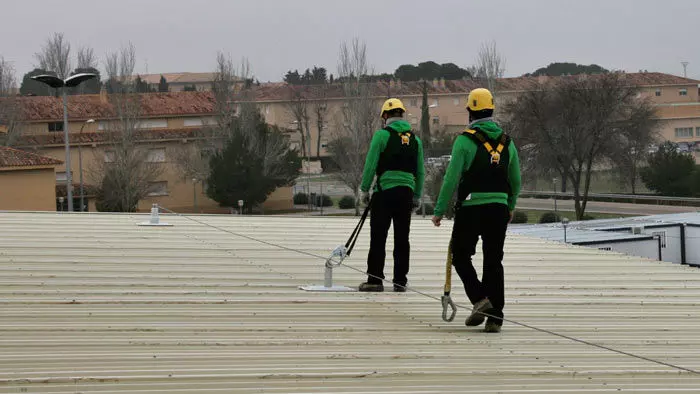Science
Structural Engineers Ensure Safety with Engineered Fall Protection Systems

Working at height presents inherent risks across various industries, including manufacturing and maintenance. Ensuring the safety of workers involves more than just purchasing fall protection gear; it requires a meticulously designed and tested engineered fall protection system. Central to this process is the role of the structural engineer, whose expertise is vital in creating systems that not only appear safe but are demonstrably reliable.
Understanding the Importance of Engineered Systems
The allure of off-the-shelf equipment, such as a 5,000-pound rated anchor bolt, can lead to dangerous assumptions. While such a rating applies to the anchor itself, it does not guarantee the integrity of the material it is affixed to. Whether it is a steel beam, a wooden truss, or a concrete slab, the underlying material must be capable of withstanding the force exerted during a fall.
A fall is not a gentle descent; it generates dynamic forces that can reach thousands of pounds within fractions of a second. Structural engineers play a crucial role in this context, performing essential calculations to differentiate between “dead loads” (static weight) and “live loads” (dynamic forces). They thoroughly assess the integrity of the building or structure, considering factors like the substrate type and condition, as well as existing loads such as snow or machinery.
The Engineer’s Comprehensive Approach
Engaging a structural engineer for a fall protection solution signifies an investment in professionalism and reliability. The process begins with a comprehensive site assessment and hazard analysis. Engineers conduct on-site evaluations, identifying fall hazards and understanding the specific tasks workers perform. This assessment informs the selection of an appropriate fall protection system, whether it requires a rigid rail for mobility, a horizontal cable lifeline, or multiple single-point anchors.
The structural engineer then moves to the design and load calculation phase, which forms the core of their responsibilities. Using the information gathered, they create systems that not only meet but exceed OSHA standards. This involves intricate calculations to ensure every component can handle the maximum potential arresting forces, addressing variables such as anchor spacing and cable tension.
Once the design is finalized, engineers produce formal, stamped engineering drawings. These documents serve as proof of compliance, detailing installation procedures, materials, and performance ratings. They are not merely suggestions; they hold legal and technical significance for qualified installations.
The role of the engineer continues during the installation phase, where oversight is critical. Many engineers ensure their specifications are strictly followed, leading to the issuance of a final certification. This certification acts as a legal assurance that the engineered fall protection system has been installed correctly and is fit for its intended purpose.
Reliability in fall protection systems is not just a matter of functionality; it also carries significant legal implications. A non-engineered system poses a liability risk, as the facility owner would need to prove adequate safety measures were in place if an incident were to occur. Without the stamp of an engineer, this task becomes exceedingly challenging.
By implementing an engineered fall protection system certified by a qualified structural engineer, facility owners establish a clear, documented defense against liability. It demonstrates due diligence and a commitment to meeting or exceeding relevant safety codes. This proactive approach fosters a culture of safety within the workplace, reassuring staff that their well-being is a priority.
When a structural engineer places their professional stamp on a design, they are committing their license and reputation to the system’s safety. This level of accountability is indispensable in creating a reliable and effective safety framework, providing peace of mind that cannot be matched by off-the-shelf solutions.
In conclusion, the expertise of structural engineers is essential in developing engineered fall protection systems that not only enhance safety but also serve as legal safeguards. As industries continue to evolve, the importance of investing in professional design and certification will remain crucial for protecting workers at height.
-

 Technology4 months ago
Technology4 months agoDiscover the Top 10 Calorie Counting Apps of 2025
-

 Health2 months ago
Health2 months agoBella Hadid Shares Health Update After Treatment for Lyme Disease
-

 Health3 months ago
Health3 months agoErin Bates Shares Recovery Update Following Sepsis Complications
-

 Technology3 weeks ago
Technology3 weeks agoDiscover 2025’s Top GPUs for Exceptional 4K Gaming Performance
-

 Technology2 months ago
Technology2 months agoElectric Moto Influencer Surronster Arrested in Tijuana
-

 Technology4 months ago
Technology4 months agoDiscover How to Reverse Image Search Using ChatGPT Effortlessly
-

 Technology4 months ago
Technology4 months agoMeta Initiates $60B AI Data Center Expansion, Starting in Ohio
-

 Technology4 months ago
Technology4 months agoRecovering a Suspended TikTok Account: A Step-by-Step Guide
-

 Health4 months ago
Health4 months agoTested: Rab Firewall Mountain Jacket Survives Harsh Conditions
-

 Lifestyle4 months ago
Lifestyle4 months agoBelton Family Reunites After Daughter Survives Hill Country Floods
-

 Technology3 months ago
Technology3 months agoUncovering the Top Five Most Challenging Motorcycles to Ride
-

 Technology4 weeks ago
Technology4 weeks agoDiscover the Best Wireless Earbuds for Every Lifestyle









